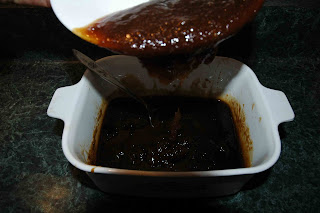 |
| A basic sourdough bread and crescents converted from a standard recipe. |
I have always assumed that that average Englishman dined on a fat loaf of bread easily broken apart by hand and used to mop up every last lick of gravy from his stew pot. I have discovered that vision is wrong. The process of grinding wheat was expensive. Baking it required a stone or clay oven especially made for the purpose. The leavening and baking took hours. Only the wealthy could afford this. Only the wealthy could afford "white" bread. The darkness of your bread was an indication of your financial and social position. The poorest people ate dark whole grain flat breads. Ironically, these were much more nutritious than the lighter leavened loaves favored by the rich.
Few people had a home oven back then. The clay or brick oven had to be preheated with a wood or coal fire, then the loaves were added and the oven sealed. By the time the oven cooled, the loaves would be ready. It was the rare household that could manage to do this on a regular basis. More commonly, the bread was started at home and sent out to be finished at a local bakery.
The bakery would have been located outside the town because such places were inclined to explode. At the time this was attributed to demons, but we know now that fine flour particles in the air reacted much like a gas to flame and were ignited by the cooking fires. It looks to me like being a baker in old England was a hazardous job!
Today we commonly think of bread as made with wheat flour. Medieval man might just as well have had rye or barley or some other grain. I would imagine that a smart landlord would order the planting of more than one grain crop. If a crop failed, there would be no truckloads brought in from hundreds of miles away. People would starve. The Irish potato famine comes to mind. This didn't happen until 1845, but is a perfect example of what happens when a population relies on a single crop.
Medieval folks didn't pick up a supply of yeast at the grocery store. Modern commercial yeast didn't exist until around 1900. The granular form most of us use today was developed by Fleishmann's during World War II. Instant yeast came on the market during the 1970's. Way back then, they would have used a sourdough starter for leavening.
Unlike granulated yeast, there's nothing remotely new about sourdough starter. Because it played such a colorful role in the history of our old west, many consider it to be uniquely American, but the Egyptians appear to have been the first to use it. The Greeks taught its use to the Romans. The Romans spread that knowledge across Europe. I admit to being intimidated at the thought of using sourdough, but this stuff crossed the continent in covered wagons and continued to leaven bread the entire trip and beyond. How hard can using it be?
Let me back up a step here. You've never heard of sourdough stories from the old west? About the "hooch" generated by sourdough? That's the alcohol that rises to the surface in a sourdough pot, perhaps another reason why sourdough was popular among prospectors! This stuff had other uses too, as a glue and as a shoe and brass polish. Remember this if you try leavening with sourdough and do not use metal containers!
Sourdough starter was a by-product of beer production. Hundreds of years ago it was a common practice for bakeries to get their starter from a brewery. Or they could have caught their own wild yeast much as you could today. This is not the easy way to get your own starter, but you might want to try it to see if you can make it work, another experiment that may make you more appreciative of today's conveniences.
To attempt to catch wild yeast for a sourdough starter, mix 4 cups unbleached white flour, 2 teaspoons salt, 2 tablespoons honey, and 4 cups water from boiling potatoes, all at room temperature, in a non-metallic container large enough to allow for double to triple expansion. Cover the container loosely (I suggest several layers of cheesecloth so yeast can enter) and set it in a warm place for two or three days. Eighty-five degrees is ideal, ninety-five is too high. You could try doing this in your kitchen if you bake a lot and may have yeast floating around, or you can go crazy and try it outside where the yeast is truly wild.
After a few days your mix will have started to froth, expand and smell sour, or it will be molding and stinky. If the first happens, your experiment has been a success and you have a starter. Stir it down and store it lightly covered in the refrigerator for a few days, then try using it in a sourdough recipe. There is no guarantee that you will like the taste. Not all yeast produces a desirable product. Try this, or wait for my next post, where I'll present some other options regarding sourdough starters and well as information on using it.
Note: Check out Pinch my Salt (November 2011)for a different, more detailed procedure for starting a sourdough starter from scratch!




















